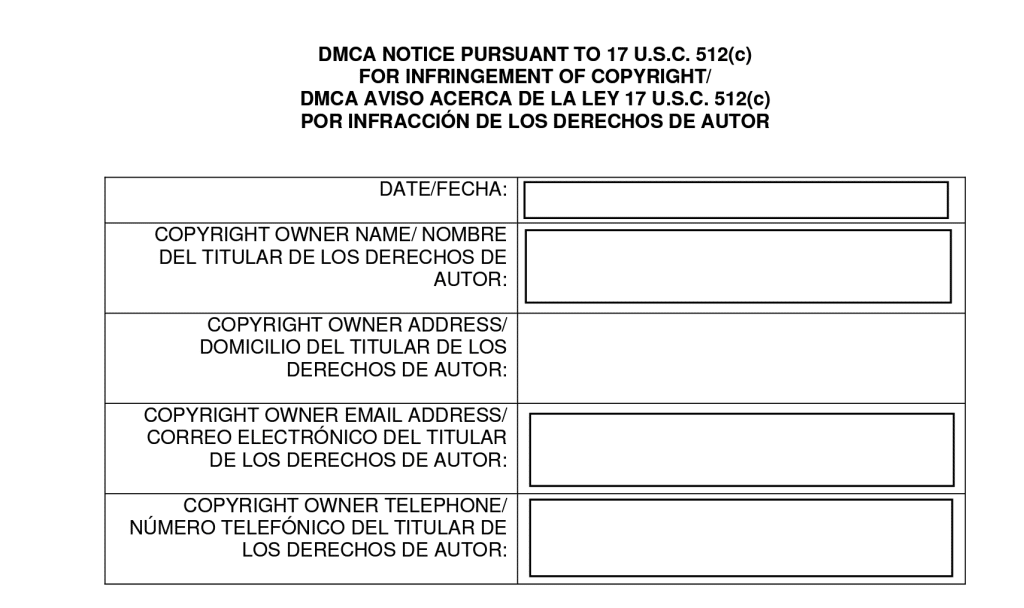If a U.S. website is using your images without your permission, the easiest and fastest way to stop the infringement is to send the website a “DMCA Takedown Notice.” DMCA stands for the “Digital Millennium Copyright Act.” Websites that host user-generated material are immune from prosecution for infringement (Safe Harbor) if the site implements notice and takedown procedures as provided for in the DMCA.
Here is a step-by-step guide to sending a DMCA takedown notice, and at the end, you’ll find a sample notice in both English and Spanish.
Step One: Find out where to send the DMCA takedown notice.
Most major websites that host content, like Facebook, YouTube, Pinterest, Flickr, eBay, and similar sites, have special sections devoted to making DMCA infringement notices. Look for a web form, email address, fax number, or mailing address on the website where you can report intellectual property infringement. Links are often buried in the website’s terms and conditions. Often, you can find the link at the bottom of a home page under the title “intellectual property.” If you look but still can’t find contact information for a takedown, consult the U.S. Copyright Office list of DMCA agents where websites are required to keep their updated contact information on file.
Step Two: Make sure your DMCA takedown notice is complete.
In order for a DMCA takedown notice to be honored by a website, it must meet certain requirements. The law requires that the notice:
- Be in writing;
- Provide the name, address, and telephone number for the person or company providing the notice;
- Identify the infringing work, by name, by description, or by providing an image;
- Identify where the work is being infringed by giving the specific internet address (URL) where the infringement can be found;
- Contain a statement that the takedown request is made in good faith, is being submitted under penalty of perjury, that the information contained in the notification is accurate, and that the request is being submitted by the copyright owner or the owner’s agent.
- Be signed (in writing or electronically) by the copyright holder or the owner’s agent.
It is also a good practice to provide more evidence that you own the work being infringed. Give the year you created the material and provide a link to your website showing the work. If you have a copyright registration, provide the number or attach the registration certificate.
If you cannot find a web form where you can submit your takedown notice, here is a sample form to use. If you want to submit multiple infringements using this form, just attach a list on a separate page.
Step Three: Check back to make sure your DMCA takedown notice was complied with.
Websites are required to remove the infringing material immediately if the takedown request complies with the law. When the material is removed, the website is required to give notice to the person who posted it and advise them that they can submit a counter-notice if they believe that the material is not infringing your rights. If no counter-notice is submitted then the material should remain off that website. If you find more infringement, go back to Step One and start over.

Click image to download this Sample Takedown Notice
What if your work is the subject of a take-down?
Sometimes takedowns are submitted mistakenly. There have been cases where takedowns are submitted maliciously to remove work that does not infringe copyright. You might also claim fair use to a work that incorporates a copyrighted work owned by someone else. What should you do in that case? Submit a counter-notice. The law requires that the counter-notice:
- Be in writing;
- Provide the name, address, and telephone number of the person or company providing the counter-notice;
- Identify the material that was removed by name, by description, or by providing an image;
- Identify where the material appeared before it was removed by providing the specific internet address (URL);
- Contain a statement that you have a good faith belief that the material was removed based upon a mistake or misidentification;
- Contain a statement that the counter-notice is being submitted under penalty of perjury; and
- Contain a statement that states that you consent to the jurisdiction of the federal court in the district where you are located, and you will accept service of process from the person who submitted the original take-down notice.
Upon receipt, the website has up to 14 days to replace the material that was accused of infringement. What happens next depends on many factors. If the person who submitted the takedown believes he is right, you might be sued for copyright infringement.
There is very little protection available if you believe that you have been the subject of improper takedowns. The DMCA does include a remedy for individuals whose material was the subject of one or more takedowns submitted in bad faith. However, bad faith is very difficult to prove because the standard is subjective bad faith.
Have you had to submit a take-down notice? How did you go about it? Tell us in the comments!
